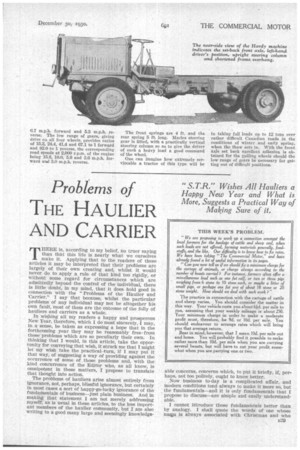A Four-wheel drive Tractor
Page 42

Page 43

If you've noticed an error in this article please click here to report it so we can fix it.
for Articulating Vehicles
Details of a Special Hardy Six cylinder Chassis for Canada, which is a Modification of aNew Standard Product for this Country
MEM auxiliary gearbox introduced by
Hardy Motors, Ltd., 46, Charing Cross, London, S.W.1, at its Slough works, which permits of two-wheel drive for ordinary purposes and four-wheel drive for difficult work, is such an extremely useful component that several uses for it suggest themselves. Ordinarily, this gearbox is being employed in a series of chassis embodying A.E.C. power units and corresponding in load capacity to the A.E.C. range of goods machines, i.e., the Mercury ai-tonner, the Monarch four-tonner, the Majestic six-tonner and the Mammoth 7-8-tonner. In our issue dated December 2nd we dealt with the Hardy four-tonner and fully explained the working of the auxiliary gearbox. We have now had an opportunity for examining a modification of what is to be the Hardy sixtonner, embodying the same principle of rear-wheel drive on its high range of gears and four-wheel drive on its low range.
The chassis illustrated on this page is to be shipped to Canada, to be used there with a semi-trailer for loads of 10-12 tons. When traversing good roads the high range of gears and two-wheel drive will be used, but for bad roads, especially in the winter, when there is much snow and ice about, the low range of gears and four-wheel drive will prove of immense value.
The design is different from that of the standard six-tonner in that the front axle has been set back so as to increase its proportion of the load. The driver is placed behind the engine and on the left-hand side, the frame overhang behind the rear axle has been shortened and the fuel tank has been mounted under the driver's seat.
The wheelbase is 13 ft. 0 in., 2 ft. shorter than it will be on the standard forward-control six-tonner. The front track is 5 ft. 8i ins., and the rear track, between the twin tyres, 5 ft. Sins. The overall length is 19 ft. 6 ins, and the overall width 7 ft. 4 ins. A frame of rather stouter members than that in the four-tonner has been employed, the sec
tion of the main members being 10 ins.
by 3 ins, by in. The frame height aaden) is 3 ft 11 in. As regards clearances, the front axle has a clearance of 1 ft. 11 in, and the rear axle 11 ins., whilst the minimum clearance between the axles (under the auxiliary gearbox) is 1 ft. S ins.; 48-in. by 8-in. tyres (twin rear) are fitted.
The A.E.C. six-cylindered petrol engine (with integral gearbox) of 110 tem. bore and 130 mm. stroke forms the power unit, this developing 56 b.h.p. at 1,000 r.p.m., and 110 b.h.p. at 2,500 r.p.m. A slightly modified sump is fitted so as to give clearance over the live front axle. This axle is of the same type as fitted to the four-tonner described in our issue dated December 2nd. but in place of the worm-driven rear axle a modification of the double-reduction axle, as fitted to the A.E.C. Mammoth 7-8-ton chassis, is used. The reduction is by spiral bevel and doublehelical gears, and the modification consists of off-setting the drive, which means using a different axle case and different half-shafts.
The turntable for the trailer portion will probably be mounted about 10 ins. ahead of the rear axle. The final-drive ratio is 8.25 to 1, although an optional ratio of 7.25 or 9.33 to 1 can be supplied if required. The high range of gears allowing drive on the rear axle only gives ratios of 8.25, 13.1, 22.2 and 36.2 to 1 forward and 44.1 to 1 reverse, the corresponding road speeds, at 2,000 r.p.m. of the engine, being 29.4, 18.5, 10.9 and
6.7 m.p.h. forward and 5.5 m.p.h. reverse: The low range of gears, giving drive on all four wheels, provides ratios of 15.3, 24.4, 41.4 and 67.1 to 1 forward and 82.0 to 1 reverse, the corresponding road speeds at 2,000 r.p.m. of the engine being 15.8, 10.0, 5.9 and 3.6 m.p.h. forward and 3.0 m.p.h. reverse. The front springs are 4 ft. and the rear spring 5 ft. long. Marks steering gear is fitted, with a practically vertical steering column so as to give the driver of such a heavy load a good command of the wheel.
One can imagine bow extremely serviceable a tractor of this type will be in taking full loads up to 12 tons over rather difficult Canadian roads in the conditions of winter, and early spring, when the thaw sets in. With the front axle set back excellent adhesion is obtained for the pulling wheels should the low range of gears be necessary for getting out of difficult positions.




























































































